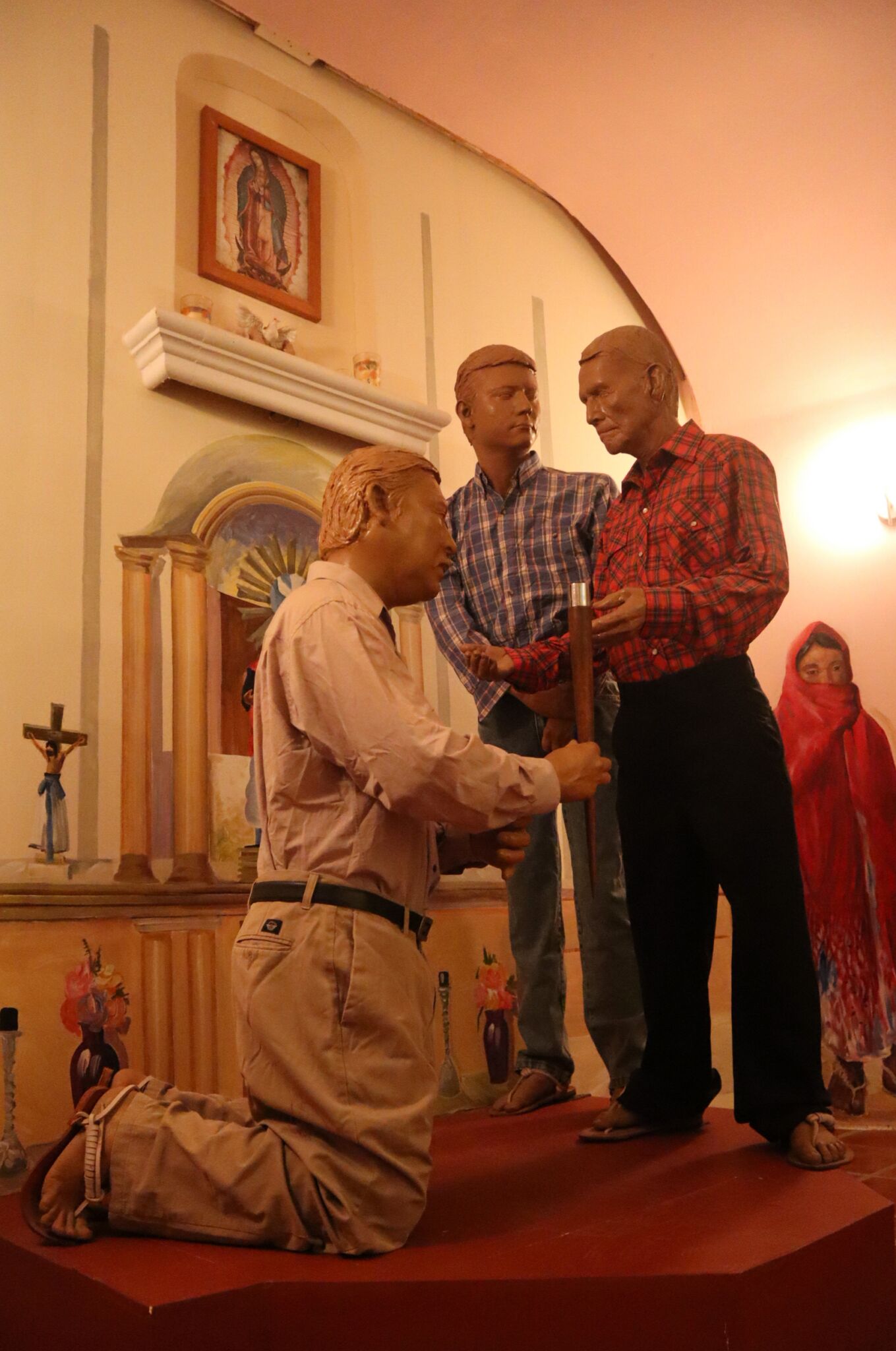-
 Danzante de PascolaDownload
Danzante de PascolaDownload
Full body male figure that fully represents the clothing of the Pascola dancer (old man of the party). The word denotes both the ritual dance and the character who participates in it. It is characterized by the use of the informer mask and by its behavior in the civil or religious ceremonies in which it participates. The informer is the mythological character who owns the arts of the Pascola dancer. In some myths he appears as a goat, a cave dweller, who attracts those who come to the mountains through dreams (Olavarría, 2003). Both the character and the dance come from the different peoples of the Cahita culture. The use of coyolis on his waist and tenábaris on his legs are of pre-Hispanic origin (Castro, 2011). But with colonization, dance adopts non-indigenous elements, such as musical instruments: harp, guitar and violin, which accompany the dancer. The dancer is dressed in a checkered blanket around the waist and thighs, and is bare-chested. He ties his hair in the form of a tachyria or "light" which signifies his relationship with the sun father. His wooden mask bears a cross on his forehead as a symbol of Christianization. While the Pascola rests he places the mask next to his head, but when he dances he covers his face with it or places it on the back of his skull. He dances hitting the ground with his bare feet, while moving the senazo rhythmically. His festive character is accompanied by jokes with sexual themes or double meanings, he makes fun of people as well as himself to break with order, which is recovered at the end of the party. A religious festival is not considered as such if the Pascolas and the Venado do not participate. During the communal festivities, a reed arbor is built, where the dancers carry out their activities (Moctezuma, 2007).
Metadata
Title
Pascola dancer
Creator
Hernández Correa, Julio
Created
2008
Type
Description
Objects: 1 light sculpture in cardboard technique and metallic internal structure; 1 Easter mask; 1 necklace; 1 blanket; 1 strip of thread; 1 coyoli; 1 senazo; 1 tenabaris.
Description
Full body male figure that fully represents the clothing of the Pascola dancer (old man of the party). The word denotes both the ritual dance and the character who participates in it. It is characterized by the use of the informer mask and by its behavior in the civil or religious ceremonies in which it participates.
The informer is the mythological character who owns the arts of the Pascola dancer. In some myths he appears as a goat, a cave dweller, who attracts those who come to the mountains through dreams (Olavarría, 2003). Both the character and the dance come from the different peoples of the Cahita culture. The use of coyolis on his waist and tenábaris on his legs are of pre-Hispanic origin (Castro, 2011). But with colonization, dance adopts non-indigenous elements, such as musical instruments: harp, guitar and violin, which accompany the dancer.
The dancer is dressed in a checkered blanket around the waist and thighs, and is bare-chested. He ties his hair in the form of a tachyria or "light" which signifies his relationship with the sun father. His wooden mask bears a cross on his forehead as a symbol of Christianization. While the Pascola rests he places the mask next to his head, but when he dances he covers his face with it or places it on the back of his skull.
He dances hitting the ground with his bare feet, while moving the senazo rhythmically. His festive character is accompanied by jokes with sexual themes or double meanings, he makes fun of people as well as himself to break with order, which is recovered at the end of the party. A religious festival is not considered as such if the Pascolas and the Venado do not participate. During the communal festivities, a reed arbor is built, where the dancers carry out their activities (Moctezuma, 2007).
Subject
Religion and culture--Sonora (Mexico : State)--Holy Week | Religious dance--Mexico | Syncretism (Religion)--Mexico | Yaquis--Social life and customs
Format
Still image / jpg
Spatial
Sonora , Cócorit
Temporal
2001 - 2010
Is part of
Music and dance room, Museum of the Yaqui people
Provenance
Museum of the Yaqui people. Sinaloa and Obregon No. 200, Cocorit, Cajeme, Sonora
Acquired for the reopening of the museum in the town of Cócorit. It is exhibited in the traditional festival room of the Museum.
Language
eng , yaqui
Date
2022-03-01
Identifier
WEB CATALOGACION OBREGON 2016-2511 | RS-OM-MEY-73
Relationship
Pascola Mask | Flute | Pascola Dancer Bells Belt | Water Drum | Pascola Drum | Moth Cocoon Ankle Rattles Pascola Length | Pascola dancer hand rattle | Annual fiesta calendar | Deer dancer | Pascola dancer video
References
Castro Silva, Tonatiuh. (2011). Etnias de Sonora. Instituto Sonorense de Cultura.
Moctezuma Zamarrón, José Luis. (2007). Yaquis: pueblos Indígenas del México Contemporáneo. México: CDI.
Olavarría, María Eugenia. (2003). Cruces, flores y serpientes. Simbolismo y vida ritual yaquis. México: UAM-Iztapalapa/Plaza y Valdés Editores.
Contributor
Sonoran Institute of Culture
Casanova, Juan (photography)
Buitimea Flores, Teodoro; Ruiz Félix, José María (investigation)
Valencia, Carlos ; The Yaqui Pride Project (translation to english)
License

This work is licensed under a Creative Commons Attribution-NonCommercial-ShareAlike 4.0 International License.
Rights
Sonoran Institute of Culture



